In the competitive world of design, a standout cover letter is your first impression and a crucial opportunity to showcase your unique skills and personality. It is more than just a formality; it’s your chance to demonstrate why you’re the perfect fit for the role and the company. A well-crafted cover letter can significantly increase your chances of landing an interview, while a generic one can easily get lost in the pile. This guide will provide actionable insights and strategies to help you create a designer cover letter that not only stands out but also gets you hired. Let’s explore the key elements that will make your cover letter shine and help you secure your dream design job.
Why a Designer Cover Letter Matters
A cover letter allows you to tell a story that a resume cannot. It provides context to your skills, experience, and personality. For designers, it’s an opportunity to demonstrate your communication skills, design thinking, and passion for the field. It shows you’ve put in the effort to understand the company and the role, setting you apart from applicants who submit generic applications. It lets you expand on your resume, highlighting relevant projects, explaining your design process, and expressing your enthusiasm for the opportunity. In a field where creativity and attention to detail are paramount, a well-written cover letter is a testament to your professionalism and commitment to excellence.
Highlight Your Design Skills
Your cover letter should be a showcase of your design skills. Instead of simply listing your skills, demonstrate them through examples. Mention specific software you’re proficient in, such as Adobe Creative Suite, Sketch, or Figma. Detail your experience with design principles like typography, color theory, and layout design. Explain how you’ve applied these skills in previous projects, highlighting the results achieved. Quantify your achievements whenever possible; for example, ‘Increased user engagement by 20% through redesigning the website’s interface.’ Use the cover letter to emphasize the skills most relevant to the job description, demonstrating that you have what it takes to succeed in the role.
Showcase Your Portfolio
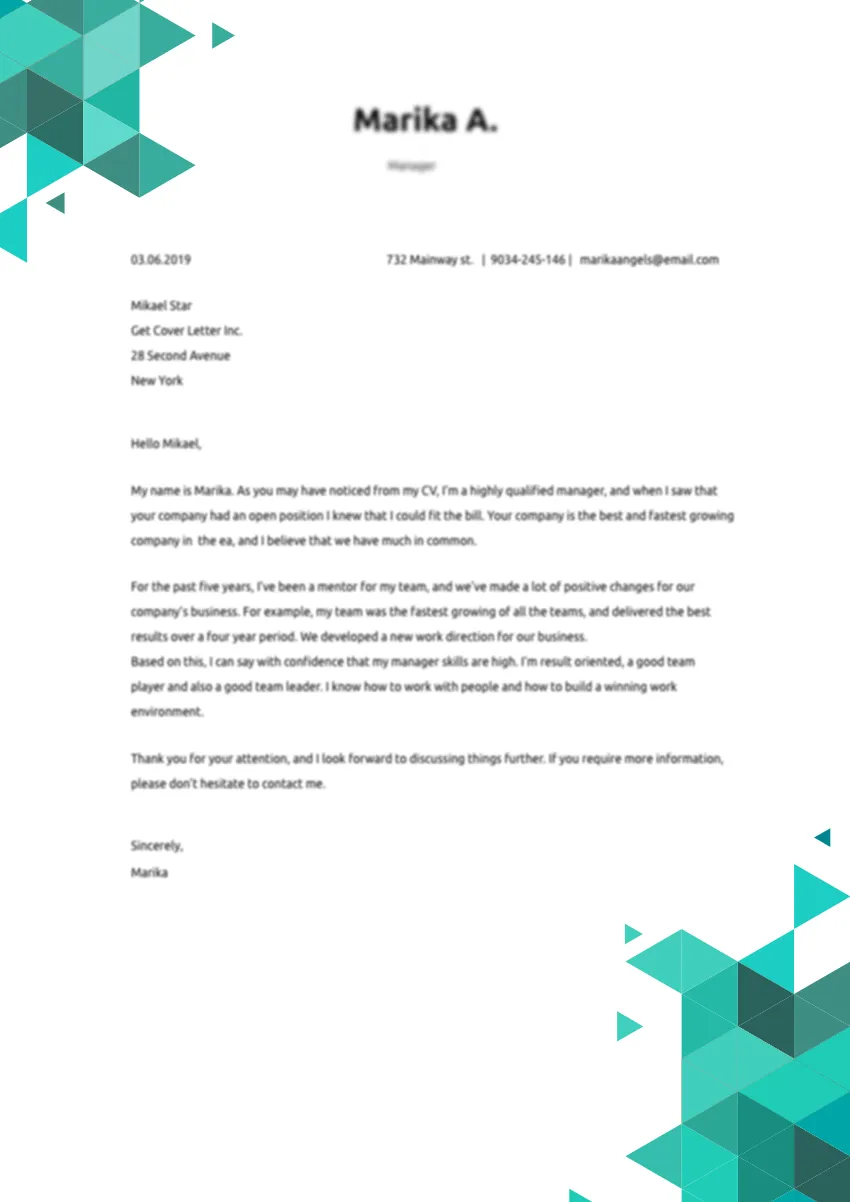
Your portfolio is the heart of your application as a designer, and your cover letter should guide the reader towards it. Provide a brief overview of your portfolio, highlighting a few key projects that align with the job requirements. Describe the challenges you faced in those projects, the design solutions you developed, and the positive outcomes achieved. Include a direct link to your online portfolio in your cover letter, making it easy for the hiring manager to access your work. If you’re applying for a specific design role, make sure your portfolio includes relevant examples of your work. Use the cover letter to pique the interest of the hiring manager, encouraging them to explore your portfolio in detail.
Tailor Your Cover Letter to the Job
Generic cover letters are a major turn-off. Customize each cover letter for the specific job and company you’re applying to. Research the company’s values, mission, and recent projects to understand what they’re looking for in a designer. Use the job description as a guide, identifying the key skills and experiences the employer values most. Highlight how your qualifications align with those requirements, providing concrete examples from your past work. Show that you understand the company’s needs and how you can contribute to their success. By tailoring your cover letter, you demonstrate that you are genuinely interested in the opportunity and have taken the time to consider how you can add value to the team.
Demonstrate Your Understanding of the Company
Before writing your cover letter, thoroughly research the company. Understand their industry, their competitors, and their design aesthetic. Mention specific projects or campaigns that resonate with you, showing that you have a genuine interest in their work. Explain how your design philosophy aligns with their brand identity. Demonstrate that you understand the company’s goals and can contribute to their success. Refer to their website, social media channels, and any recent news or articles about the company. Demonstrating a deep understanding of the company sets you apart from other applicants who may not have done their homework. It shows you are a proactive and engaged candidate who is truly interested in the opportunity.
Emphasize Your Problem-Solving Abilities
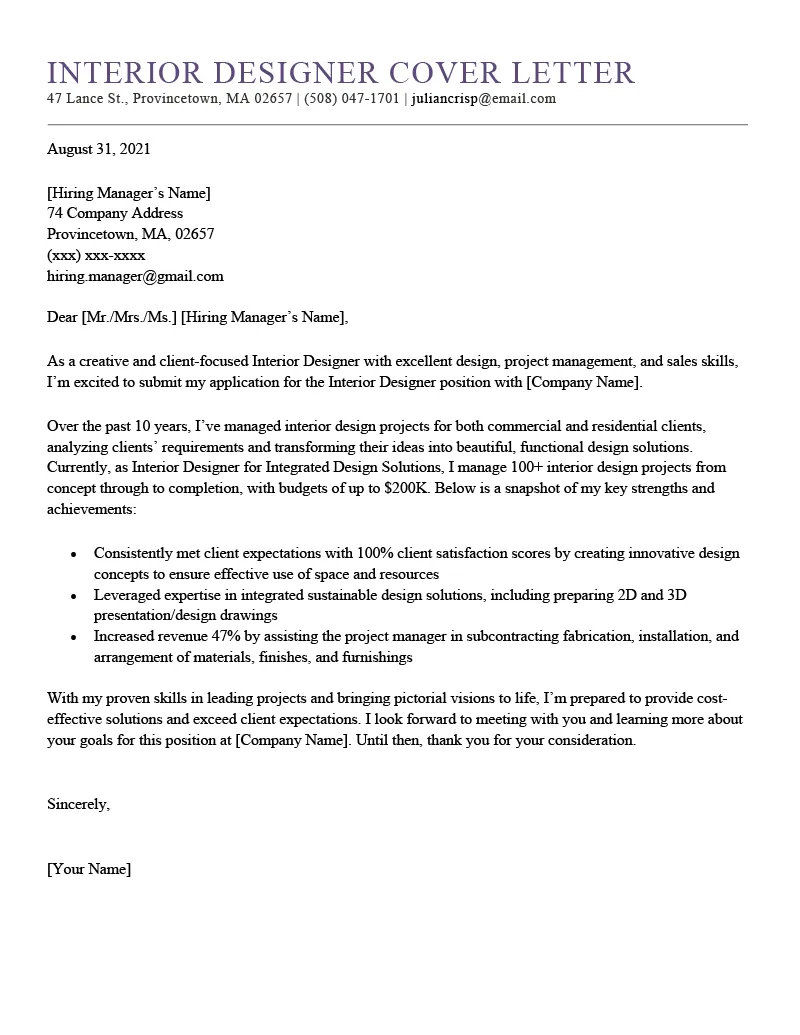
Design is inherently about problem-solving. Use your cover letter to showcase your ability to identify challenges, develop creative solutions, and achieve desired outcomes. Provide examples of projects where you faced specific design challenges, such as improving user experience, increasing engagement, or meeting tight deadlines. Explain the strategies you used to solve those problems, highlighting your design process and critical thinking skills. Emphasize how you translated complex requirements into visually appealing and effective designs. Demonstrating your problem-solving abilities proves your versatility and ability to adapt to different situations, essential qualities in a designer.
Use Action Verbs and Quantify Achievements
Start your sentences with action verbs to make your cover letter more impactful. Use words like ‘created,’ ‘designed,’ ‘developed,’ ‘implemented,’ ‘improved,’ and ‘achieved.’ When describing your accomplishments, quantify them whenever possible. Instead of saying ‘Improved website usability,’ say ‘Improved website usability by 30% through user testing and iterative design.’ Quantifying your achievements provides concrete evidence of your skills and the value you bring to the table. Use numbers, percentages, or specific metrics to highlight the impact of your work. This demonstrates your ability to achieve measurable results, making your cover letter more persuasive and memorable.
Proofread and Edit Your Cover Letter
Errors in your cover letter can undermine your credibility as a designer. Before submitting your application, carefully proofread your cover letter for any grammatical errors, spelling mistakes, or typos. Ensure your writing is clear, concise, and easy to read. Consider having a friend or colleague review your cover letter as well. They may catch errors you overlooked and provide valuable feedback. Pay attention to the tone and style of your writing. Make sure it is professional and reflects your personality and brand. A polished and error-free cover letter demonstrates your attention to detail and professionalism, making a positive impression on the hiring manager.
Cover Letter Structure and Format
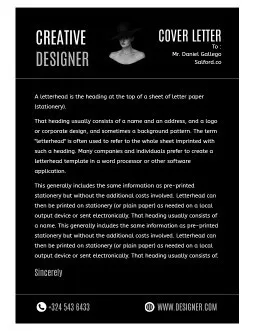
The format and structure of your cover letter are critical for making a positive first impression. Use a clean, easy-to-read font like Arial or Calibri. Keep the letter concise, ideally one page in length. Use a standard business letter format, including your contact information, the date, and the hiring manager’s name and title. Use clear headings and subheadings to organize your content. Break up large blocks of text into smaller paragraphs to improve readability. Avoid using excessive jargon or overly complex language. Keep the layout clean and uncluttered, with sufficient white space. The structure and format of your cover letter should reflect your design sensibility and attention to detail.
Contact Information and Salutation
Start your cover letter with your contact information, including your name, address, phone number, and email address. If you have a professional website or online portfolio, include the link as well. Address the hiring manager by name whenever possible. Research the name and title of the person who will be reviewing your application. Avoid generic salutations like ‘To Whom It May Concern.’ Use a professional and respectful greeting, such as ‘Dear Mr./Ms. [Last Name].’ If you can’t find the hiring manager’s name, use a general greeting like ‘Dear Hiring Manager.’ Always maintain a professional tone throughout your cover letter.
Body Paragraphs Content
The body of your cover letter is where you highlight your skills, experience, and qualifications. Start with a strong opening paragraph that captures the reader’s attention and expresses your interest in the role. Briefly explain why you are interested in the company and the specific position. In the following paragraphs, highlight your relevant experience and skills, providing examples from your past projects. Showcase how your qualifications align with the job requirements. Explain your design process and how you approach design challenges. Quantify your achievements whenever possible. Use action verbs and focus on what you can bring to the team. Conclude with a compelling closing paragraph summarizing your qualifications and expressing your enthusiasm for the opportunity.
Closing and Call to Action
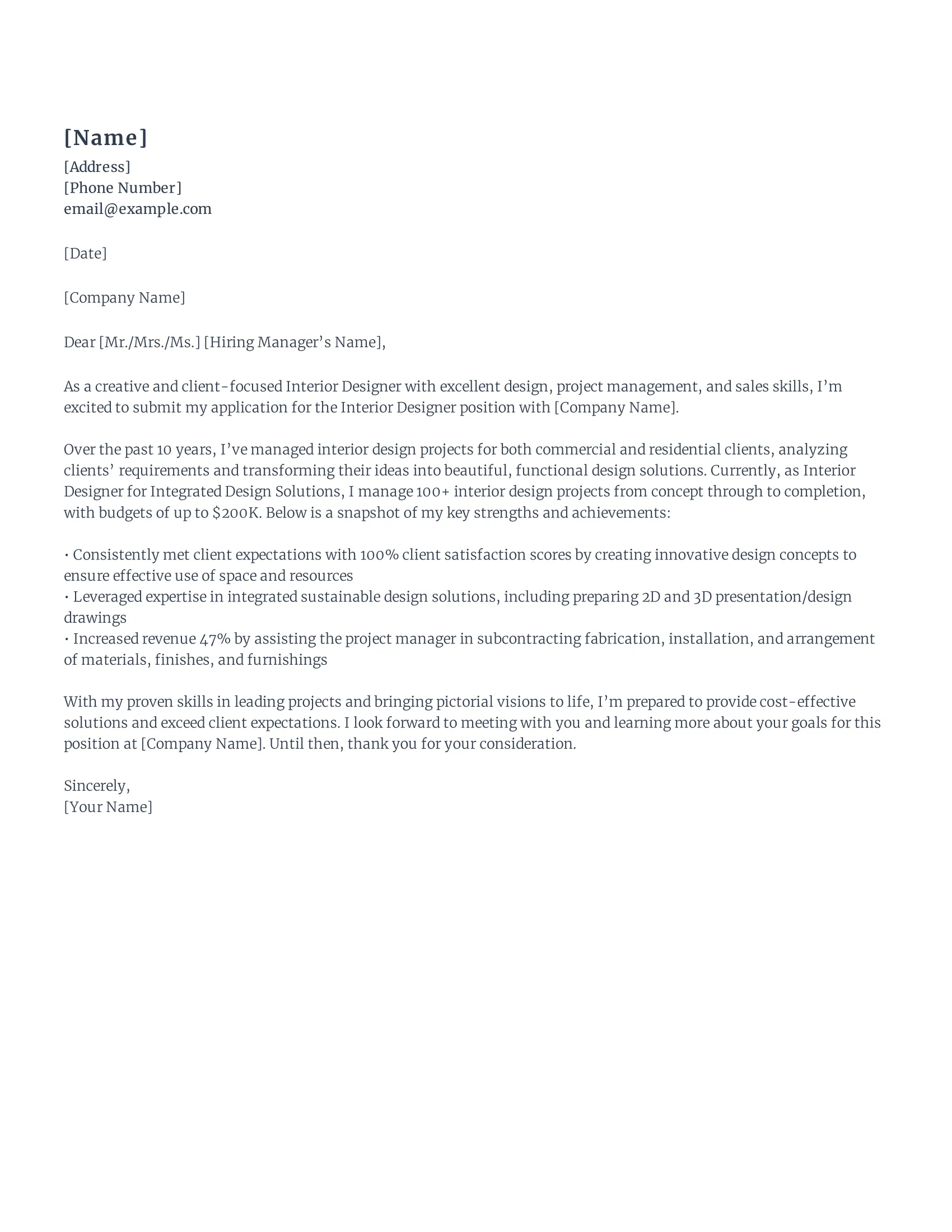
Your closing paragraph should reiterate your interest in the position and thank the hiring manager for their time and consideration. Express your enthusiasm for the opportunity to discuss your qualifications further. Include a clear call to action, such as ‘I look forward to hearing from you soon’ or ‘Thank you for considering my application. I am eager to discuss how my skills and experience can benefit your team.’ Reiterate your contact information, making it easy for the hiring manager to get in touch with you. End with a professional closing, such as ‘Sincerely,’ or ‘Best regards,’ followed by your name.
Examples of Effective Cover Letter Phrases
Use effective phrases to make your cover letter more impactful and persuasive. Here are some examples:
- ‘I am writing to express my keen interest in the [Job Title] position at [Company Name].’
- ‘With [Number] years of experience in design, I have a proven track record of creating [Type of Design].’
- ‘In my previous role at [Previous Company], I was responsible for [Key Responsibilities].’
- ‘I am particularly drawn to [Company Name]’s [Specific Project or Initiative].’
- ‘My portfolio, available at [Portfolio Link], showcases my ability to [Key Skills].’
- ‘I am confident that my skills and experience align perfectly with the requirements of this role.’
- ‘I am eager to discuss how my design expertise can contribute to [Company Name]’s success.’
- ‘Thank you for considering my application. I look forward to the opportunity to speak with you soon.’
Common Mistakes to Avoid in Your Cover Letter
Avoid these common mistakes to make your cover letter as effective as possible:
- Generic Cover Letters: Customize each cover letter to the specific job and company.
- Typos and Grammatical Errors: Proofread carefully and have someone else review your letter.
- Too Much Text: Keep it concise and easy to read.
- Focusing on Yourself Too Much: Highlight how your skills can benefit the company.
- Listing Responsibilities Instead of Achievements: Focus on what you’ve accomplished.
- Ignoring the Job Description: Tailor your letter to the job requirements.
- Using Jargon and Buzzwords: Write in clear, understandable language.
- Including Irrelevant Information: Focus on the skills and experience that matter most.
Focusing on Relevant Experience
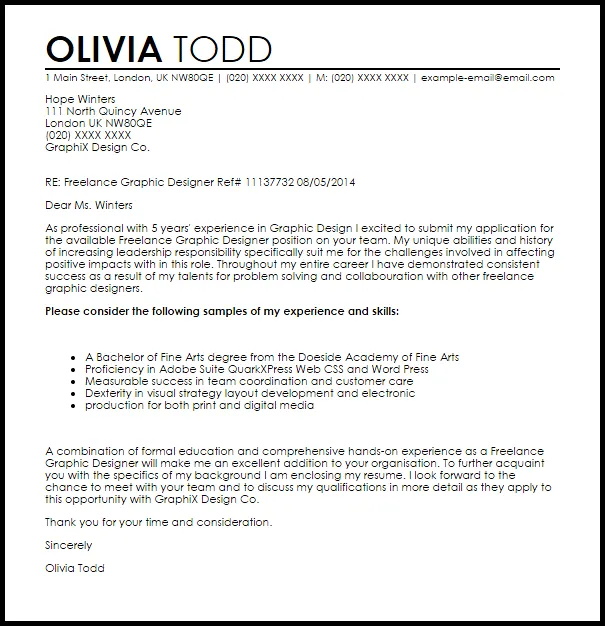
Prioritize the experience most relevant to the job. Instead of listing every job you’ve held, focus on the projects and roles that align with the requirements of the position. Highlight specific accomplishments and responsibilities that demonstrate your skills and expertise. Provide detailed explanations of how you applied your design skills to achieve positive outcomes. If you have experience in a related field, explain how those skills are transferable to the design role. Use examples from your previous work to support your claims. By focusing on relevant experience, you show the hiring manager that you have the qualifications they are looking for.
Addressing Skills and Accomplishments
Don’t just list your skills; demonstrate them. Explain how you’ve used your skills to achieve specific accomplishments in your previous roles. Provide concrete examples of your design projects, detailing the challenges you faced, the solutions you developed, and the results you achieved. Quantify your accomplishments whenever possible. Instead of saying ‘Improved website traffic,’ say ‘Increased website traffic by 40% through a redesigned user interface.’ Show that you can deliver measurable results. This demonstrates your ability to apply your skills to real-world situations. Your cover letter should be a testament to your achievements.
Finalizing and Submitting Your Cover Letter
Before submitting your cover letter, take one final look. Ensure that the formatting is correct, the writing is clear, and the content is relevant to the job. Make sure you have included your contact information and a direct link to your portfolio. Check that you have addressed the hiring manager correctly and used a professional tone throughout. Save your cover letter as a PDF to preserve the formatting. Proofread one last time for any errors. Submitting a polished and well-crafted cover letter is the final step. Your cover letter is a critical part of your application, so take the time to create one that showcases your design skills and sets you apart from the competition.
By following these guidelines, you can create a designer cover letter that grabs attention and increases your chances of landing an interview. Remember, your cover letter is your opportunity to shine. Make it count!
